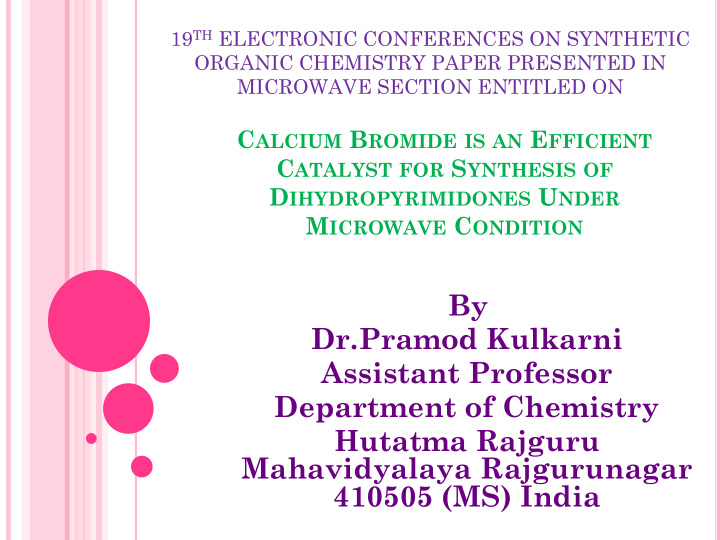



19 TH ELECTRONIC CONFERENCES ON SYNTHETIC ORGANIC CHEMISTRY PAPER PRESENTED IN MICROWAVE SECTION ENTITLED ON C ALCIUM B ROMIDE IS AN E FFICIENT C ATALYST FOR S YNTHESIS OF D IHYDROPYRIMIDONES U NDER M ICROWAVE C ONDITION By Dr.Pramod Kulkarni Assistant Professor Department of Chemistry Hutatma Rajguru Mahavidyalaya Rajgurunagar 410505 (MS) India
I MPORTANCE OF D IHYDROPYRIMIDINONES Dihydropyrimidinones shows following important biological activity Calcium channel blockers Antihypertensive Anticancer agents Antidiabetic activity Antithrombotic agent Carbonic anhydrase inhibitor α 1a -adrenergic antagonists Neuropeptide Y (NPY) antagonists Antileishmanial
T HE B IGINELLI REACTION The synthesis of these compounds firstly reported by the Biginelli in 1893. The Biginelli reaction, is a direct and simple approach for the synthesis of 3,4- dihydropyrimidinones by one-pot cyclocondensation of ethyl acetoacetate, benzaldehyde and urea in the presence of strong acid. Shortcomings of this method is low yield, strongly acidic reaction condition.
M ODIFICATIONS OF B IGINELLI R EACTION ZnCl 2 /TBAB LiBr Cu(OTf) 2 FeCl 3 .6H 2 O, NiCl 2 .6H 2 O Zr(H 2 PO 4 ) 2 Sodium Selenate Lanthanide Triflate Indium (III) Chloride CdCl 2
Silica sulphuric acid Mesoporous silica MCM-41 t -BuOK Y(NO 3 ) 3 .6H 2 O Iron (III) trifluoroacetate and trifluoromethanesulfonate CaF 2 PEG-embedded thiourea dioxide 12-Molybdophosphoric acid
Chlorosulfonic acid Nafion-H Cobalt nitrate Silica-gel Silica-bonded S -Sulfonic acid [ NaIO 4 Aluminatesulfonic acid nanoparticles [ Trichloroisocyanuric acid
1,3-Dichloro-5,5-dimethylhydantoin Nano-TiCl 4 .SiO 2 FePO 4 .2H 2 O LaCl 3 /ClCH 2 COOH Other methods, for synthesis of dihydropyrimidiones are ionic liquid microwave irradiatio and ultrasound
C ALCIUM B ROMIDE IS NEW CATALYST IN ORGANIC SYNTHESIS Calcium bromide is the calcium salt of hydrobromic acid. Calcium bromide is obtained by the interaction of bromine and milk of the lime in the presence of ammonia. It is readily soluble in water and absolute ethanol . It is thermally and chemically stable. Use of calcium bromide in organic synthesis is very rare
R ESULTS AND D ISSCUSSION Calcium bromide is polar covalent molecules due to high electronegative difference between calcium and bromine. The binding electron pair in calcium and bromine is pulled towards bromine atom, forming a diploe within the molecule. Due to this dipole calcium bromide absorbs microwave energy and converts into heat. This generated heat used to bring reaction between urea, benzaldehyde and ethyl acetoacetaete.
To lead off the reaction conditions for the calcium bromide catalyzed Biginelli condensation under microwaves, the reaction of benzaldehyde with ethyl acetoacetate and urea was taken as a model reaction . I tested to optimize the reaction conditions by changing the quantities of calcium bromide from 0 mole% - 20 mole%. It was noted that the condensation reaction can be efficiently carried out by taking 2mol% of the catalyst at 400w, in a short time span of only 1.5 to 3 minutes, which is much lesser and yield is high as compared to other catalysts using more than 5 to 20mol%. A further increase in the catalyst amount does not show any noticeable increase in the product yield (Table 1).
Table 1. Optimising amount of catalysts for synthesis of dihydropyrimidiones % Yield b Entry Amount of Time in catalyst in Minutes mol% 1 0 15 25 2 0.5 10 41 3 1 5 52 4 2 2 94 5 5 2 95 6 10 1.5 95 7 15 1.5 95 8 20 1.5 94
21 examples with electron withdrawing as well as electron donating substituent's on benzaldehyde, yield in the range from 72 % to 94 % Notably, this protocol is compatible with a wide range of functional groups such as methoxy, halides, nitro, hydroxyl, N, N -dimethyl-, and acid sensitive compound like cinnamaldehyde, furfural aldehyde could afford the corresponding products in excellent yield as well.
C ONCLUSION In summary, here I reported an efficient synthesis of dihydropyrimidinones and dihydropyrimidinthiones using calcium bromide as a catalyst under microwave condition. The mild reaction conditions, rapid formation of product, high yields, inexpensive and easily available catalyst, are some notable merits of this method.
Moreover, compatibility with the environment, more efficiency and easy separation of catalyst after synthesis are considered as another merit of this method. Most importantly, absence of organic solvents and use of microwave irradiation as an alternative energy source which obey principles number two and five out of the twelve principles of green chemistry, due to this, method contributes it to the development of green technology.
THANK YOU
Recommend
More recommend